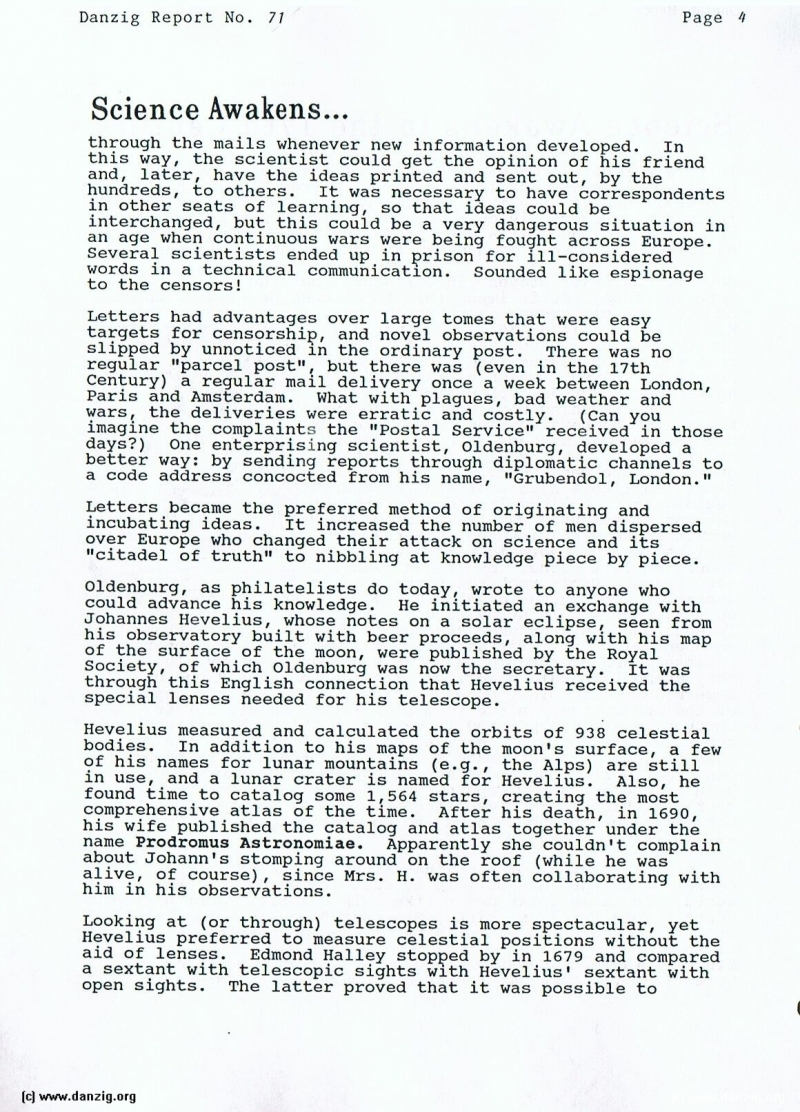
Science Awakens...
through the mails whenever new information developed. In this way, the scientist could get the opinion of his friend and, later, have the ideas printed and sent out, by the hundreds, to others. It was necessary to have correspondents in other seats of learning, so that ideas could be interchanged, but this could be a very dangerous situation in an age when continuous wars were being fou9ht across Europe. Several scientists ended up in prison for ill—considered words in a technical communication. Sounded like espionage to the censors!
Letters had advantages over large tomes that were easy targets for censorship, and novel observations could be slipped by unnoticed in the ordinary post. There was no regular “parcel post”, but there was (even in the 17th Century) a regular mail delivery once a week between London, Paris and Amsterdam. What with plagues, bad weather and wars, the deliveries were erratic and costly. (Can you imagine the complaints the “Postal Service” received in those days?) One enterprising scientist, Oldenburg, developed a better way: by sending reports through diplomatic channels to a code address concocted from his name, “Grubendol, London.”
Letters became the preferred method of originating and incubating ideas. It increased the number of men dispersed over Europe who changed their attack on science and its “citadel of truth” to nibbling at knowledge piece by piece.
Oldenburg, as philatelists do today, wrote to anyone who could advance his knowledge. He initiated an exchange with Johannes Hevelius, whose notes on a solar eclipse, seen from his observatory built with beer proceeds, along with his map of the surface of the moon, were published by the Royal Society, of which Oldenburg was now the secretary. It was through this English connection that Hevelius received the special lenses needed for his telescope.
Hevelius measured and calculated the orbits of 938 celestial bodies. In addition to his maps of the moon’s surface, a few of his names for lunar mountains (e.g., the Alps) are still in use, and a lunar crater is named for Hevelius. Also, he found time to catalog some 1,564 stars, creating the most comprehensive atlas of the time. After his death, in 1690, his wife published the catalog and atlas together under the name Prodromus Astronomiae. Apparently she couldn’t complain about Johann’s stomping around on the roof (while he was alive, of course), since Mrs. H. was often collaborating with him in his observations.
Looking at (or through) telescopes is more spectacular, yet Hevelius preferred to measure celestial positions without the aid of lenses. Edmond Halley stopped by in 1679 and compared a sextant with telescopic sights with Hevelius’ sextant with open sights. The latter proved that it was possible to
Danzig Report Vol. 1 - Nr. 71 - April - May - June - 1991, Page 4.
Hits: 3990
Added: 30/06/2015
Copyright: 2025 Danzig.org

